What Does Hydration Mean
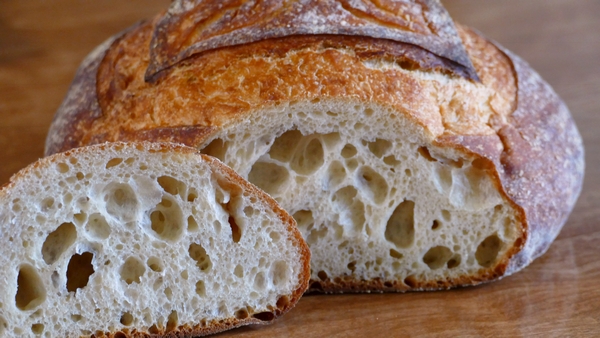
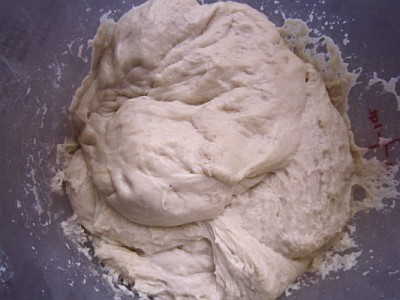
What Does Hydration Mean – in Baking Terms? (This is an excerpt from my Sourdough Bread Baking 101 course)
Teresa L Greenway Northwest Sourdough – all rights reserved worldwide
Hydration, in bread baking terms, means how much water or liquid there is in a given amount of flour, or the ratio of water to flour weight. More water means a higher hydration or wetter dough. Less water means a lower hydration or drier, stiffer dough. Understanding hydration allows a baker to know approximately how wet or dry dough will be. An average lower hydration dough might be around 60% – 64% hydration (an average hydration used in large scale bakeries). Wet high hydration Ciabatta dough might be around 75 %- 85% hydration.
Hydration is figured out by the weight of the water as a percentage of the weight of the flour. Both ingredients are weighed and then the total amount of water by weight is divided by the total amount of flour by weight. So if you have 4 oz of water and 5 oz of flour you divide 4/5 and get 80 % hydration. 80% hydration is a very thick batter, like what might be mixed up if you make muffins or cornbread. In metric it might look like this: the water is 40 grams, flour is 50 grams, divide 40 by 50 and you have 80 %.
The lower hydration doughs are firmer and drier in the 50 – 64 % range of hydration. The medium hydration doughs are stickier and wetter at around 65 % to 76% hydration and the very high hydration doughs are more like a thick batter and are extremely wet and sticky at 77% and up. 100% hydration does not mean 100% water with no flour. It does mean 100% of the weight of the flour is also the same weight of the water.
So for instance, 80 grams of water and 80 grams of flour mixed together would make a 100% hydration mixture. It is 100% hydration because the water weight is 100% of the flour weight. You can have batters (like a pancake or muffin batter) at more than 100% hydration by having more water by weight than flour.
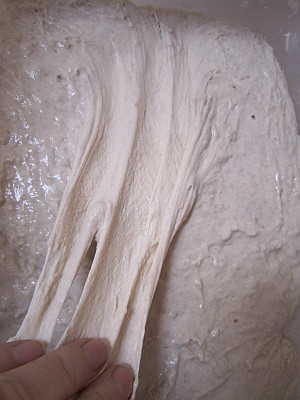
Very wet sourdough starters might be kept at around 166% hydration. That is, a one to one ratio, by volume, like one cup (8.3 oz) of water to one cup (5 oz) of flour (for metric it might be 166 grams of water to 100 grams of flour). Another popular hydration for starters is 100% hydration, which is a one to one ratio, by weight, of water to flour, like 5 ounces of water to 5 ounces of flour or 50 grams of water to 50 grams of flour. This hydration will make a much thicker batter or starter.
I like to keep my whole grain starters at 100% hydration or lower, because they tend to ferment faster and can be slowed down somewhat when they are kept thicker (a wetter mixture ferments more quickly). A thicker or lower hydration starter is also stronger since it is more concentrated as far as fermentation organisms.
You might keep your white starters at the more liquid batter of 166% hydration for a couple of reasons. In a more liquid state the gluten does not form binding strands which are harder to incorporate into the final dough during mixing. It ferments faster but the bubbles escape so that you do not have to worry about the mixture crawling out of its container, it is easier to measure if you use a measuring cup, and I believe it helps make the dough more extensible and have an open crumb. You can also obtain a better “sour” with a liquid starter which is kept warm. Large scale bakeries sometimes use a very wet starter because it is easy to feed and it is easier to pump the liquid starter when mixing huge batches of dough.
However, many (most) bakers keep a 100% hydration sourdough starter because of the ease of use. A lower hydration starter doesn’t ferment as quickly as a wetter starter. Also, it is much easier to do baker’s math when you know that exactly half of the weight is water and half is flour.
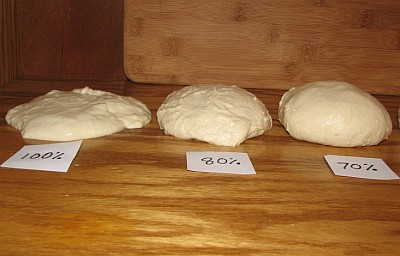
This photo was taken right after mixing the dough. As soon as it starts fermenting, it begins to break down and look wetter.
Most bakers keep their sourdough starters at 100% hydration for the ease of figuring out their formulas and because the starter will ferment more slowly than a very wet starter.
Formulas for bread baking most often use 100% starters and less often they use a 166% hydration starter. To turn a 100% hydraton starter into a 166% hydration starter if your formula calls for 166% starter and you only have a 100% starter:
Convert your 100% hydration starter to 166% easily by:
Combine 191 grams of starter at 100%hydration and 63 grams of water, you will have approximately 1 cup/ 9oz ofstarter at 166%.
191 grams (100% starter) plus 63 grams of water = I cup/ 9ounces/254 grams (of starter at 166% hydration)
The formulas in my books, “Discovering Sourdough,” are based off one cup of 166% sourdough starter which equals 9 ounces/254 grams of starter (at 166%).
Getting a good tangy sour flavor depends upon many factors, like your technique, timing, temperature, starter, formula etc. A wetter liquid batter favors lactic acid, which is where much of the complex flavor is obtained. Drier dough favors acetic acid which contributes to the souring of the dough, however it takes longer to ferment. I personally have found that a wetter warmer starter favors a more “sour” dough (although you will find that others tell you otherwise). So timing and temperature play an important factor in obtaining a sour flavor.
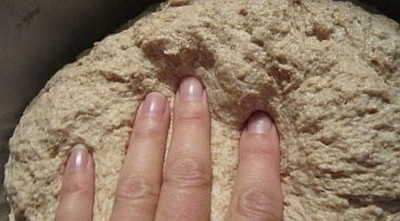
An interesting combination is to use a wet starter and drier starter in making the dough. This should contribute both a great flavor and sourness to the finished loaf. Making up a batch of 60 – 80 % hydration dough using a whole grain starter, and allowing it to age for several days at cool temperatures(this would be called a motherdough, which is covered in another lecture), then adding it to your final dough, would be another way of adding more flavor to your bread.
Using a mature lower hydration motherdough and then bulk fermenting (bulk fermentation is the first ferment after mixing the dough) at a warm temperature is another way to get a tangy bread. Since living in Hawaii and baking in a warm, humid environment, I have found it much easier to get consistently sour bread, so temperature seems to be important in obtaining a sour flavor. There are as many techniques for obtaining a great sour flavor as there are bakers.
I find that working with sourdough is an evolving process and what I prefer now, often changes as my interests change. It is also a learning process and what I understand and like to do now, changes as time and experience shows me new or better techniques. I have always liked working with stickier, wetter dough, but have found a recent interest in working with the lower hydration, drier dough which when baked, can be surprisingly airy, light and full of holes.
So now I am experimenting with drier dough which I bulk ferment at warm temperatures. I have also been working with white starters kept at 50 -60% hydration (a stiff Biga-like dough) and have found a whole new range of possibilities. I have worked with refrigerated “motherdoughs” at 50 – 80% hydration and find them different to work with than either the 166% white starter or the 100% whole grain starters.

In the e-book (available as an email opt in when you visit this site), “Make Your Own Sourdough Starter,” there are several formulas for motherdough and pre-ferments at different hydrations included in the book.
Happy Baking Everyone! Teresa
Join me in my online baking course: Sourdough Baking 101

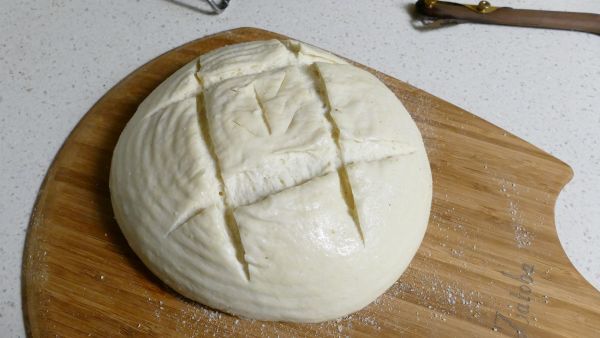
Responses